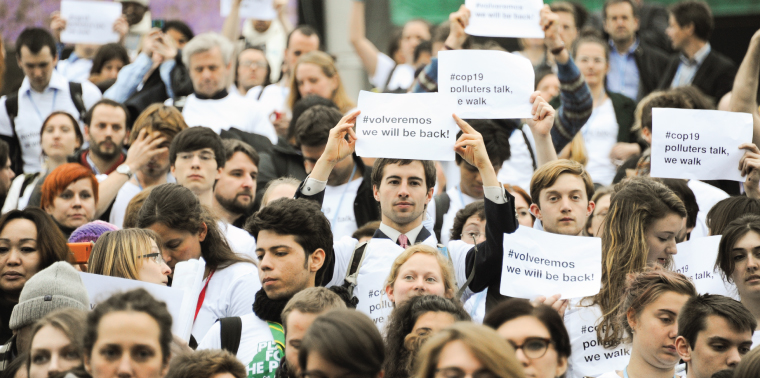November 25, 2013 — “These talks are no longer about developed against developing countries. It’s now about the willing against the unwilling.”
That was the view of the spokesman for the European Union’s climate chief, speaking in the final hours of the marathon overtime United Nations COP 19 climate change talks, which ended Saturday. He was referring to the emergence of new divisions within the talks — alignments that are redrawing old battle lines and offer both the hope of shaking up the entrenched attitudes that have stalled agreement in the past and the real danger that these 20-year-old annual conferences will break down completely.
This year’s two-week conference took place in Warsaw, Poland. The aim was to lay the groundwork for the U.N. Conference on Climate Change slated for in Paris in late 2015, at which nations are supposed to sign a historic new global agreement on greenhouse gas emissions, to come into force in 2020.
Nothing much of interest was supposed to come out of Warsaw: Ed Davey, the U.K.’s energy and climate secretary, summed up the subdued mood going into the talks as hoping for “modest progress on modest objectives.” But from the outset the stakes turned out to be much higher than that.
Stormy Start
The talks opened Nov. 11, days after Typhoon Haiyan struck the Philippines. Yeb Sano, the Filipino negotiator, made an emotional speech linking the devastation to global warming and calling for a new sense of urgency to tackle emissions. He then fasted throughout the fortnight.
What followed his speech, however, was a series of bitter rows, alleged walkouts and recriminations. Japan was castigated for cancelling its previous commitment to a 25 percent emissions cut by 2020 in favor of a 3 percent increase in emissions over 1990 levels, owing to the Fukushima disaster and loss of nuclear power.
The issue of “loss and damage” also caused upsets. Some developing countries interpret this phrase as denoting compensation from the rich world to the poor, to cover the damage they suffer from extreme weather and associated disasters. But developed countries will not accept the term “compensation” or legal liability. This was finally resolved with a compromise on a “Warsaw international mechanism” [PDF] that will channel funds to developing countries stricken with disaster.
The Big Divide
But the real acrimony and discord came at the very end, amid the emergence of the new divisions the EU spokesman alluded to. A new grouping called the “like-minded developing countries,” which claims to represent more than half the world’s population, demanded the dilution of key aspects of the agreement. The roots of the group reach back to the 2011 Durban climate talks, at which the EU assembled a formidable coalition of poor and rich countries in favor of working on a post-2020 agreement. Months later coal-rich China and India joined a small group of others, including oil-rich nations including Venezuela, Saudi Arabia, Bolivia and Malaysia and some countries with links to the above, including Cuba, Nicaragua, Ecuador and Thailand, to form the “like-minded” group.
The central tenet of their argument is that the strict separation of countries into “developed” and “developing,” set at the first UN talks in 1992 and enshrined in the 1997 Kyoto protocol, must remain in any future agreement. The U.S. and the EU are firmly opposed to this delineation, which they say no longer reflects reality: China is the world’s biggest greenhouse gas emitter and second biggest economy, and combined emissions from developing countries are on track to overtake those of the developed world by 2020.
For most of the past two decades of negotiations, developing countries have been broadly aligned. But the emergence of the “like-minded” group shows that not all developing countries share the same interests. Some of those rapidly industrializing see emissions agreements as prohibitive, while others that are highly vulnerable to climate change want swift global emissions cuts as well as adaptation financing.
Todd Stern, U.S. special envoy for climate change, said: “This is now the major fault line at the talks.” He said the insistence on basing a post-2020 agreement on “unchanging 1992 categories is more pronounced than at Durban and poses the biggest challenge to the negotiations in the next two years.”
Next Up?
For the next two years, both sides will be busy courting the other developing governments. The U.S. and the EU want to persuade vulnerable nations that they have most to gain from an agreement on emissions; China, India and other emerging economies are trying to build their spheres of influence among poor countries anxious for investment and allies.
Governments have until the first quarter of 2015 to set out their “contributions” to cutting greenhouse gas emissions. Between now and Paris, there are two more significant meetings — the New York summit of world leaders to be held by Ban Ki-moon next September, and the COP 20 talks planned for Lima, Peru, this time next year. If Warsaw is anything to go by, it will be a bumpy ride. ![]()
Ensia shares solutions-focused stories free of charge through our online magazine and partner media. That means audiences around the world have ready access to stories that can — and do — help them shape a better future. If you value our work, please show your support today.
Yes, I'll support Ensia!
